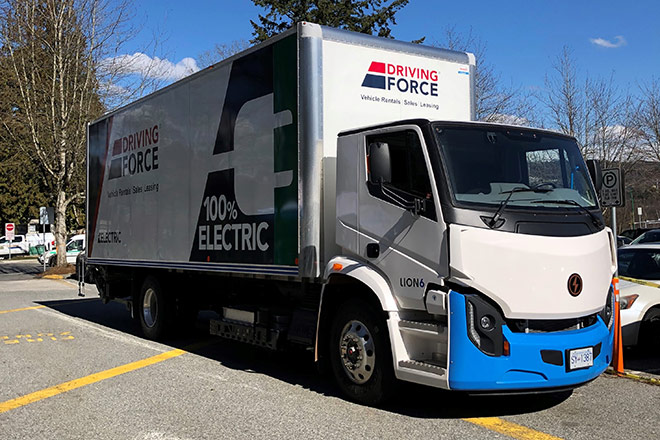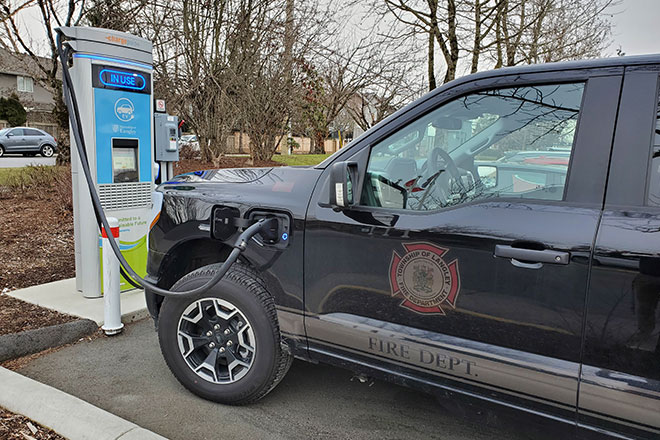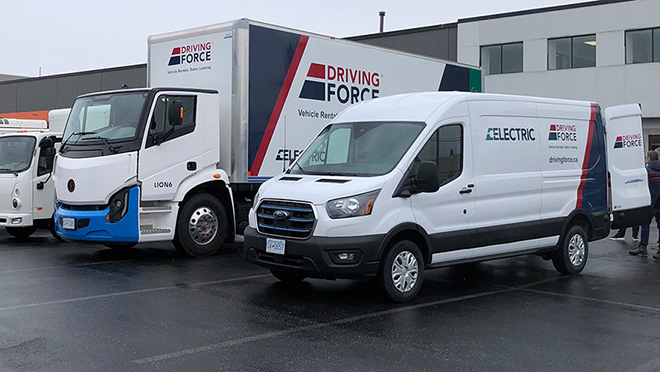Electric vans, trucks on the way: ready for EV fleets?

EV test-drive events, cost savings, create buzz among fleet operators
A shortage of model options. Long wait times for vehicle orders. Prohibitive costs. And no idea how to go about converting a fleet of vehicles to electric.
Until recently, those were the frequent complaints, or at least expressed reservations, among fleet operators looking at the prospect of converting at least part of their fleets off gas and into electric vehicles. But the rising price of gas, a series of deep-dive webinars, a slew of available rebates, and two well-attended EV fleet test-drive events in B.C., have sparked new optimism.
There's nothing quite like climbing into a Ford E-Transit, Ford F-150 Lightning, Lion6 truck, or a GreenPower bus to change your perspective.
"I don't know the exact attendance numbers at the test-drive events – I'd say somewhere between 30 and 50 per event," says BC Hydro's Jason Scultety, who attended both Plug'n Drive events in March, one in Burnaby, and the other in Langley. "But we had quite the mix of people. We had some of our key accounts from government, municipalities, Metro Vancouver, the film industry, and health care. And there were some new faces, such as people in the mobile food industry. I really like the diversification of the different types of customers showing interest."
There are a growing number of fleet-related vehicles available in Canada, from light-duty cars to vans, trucks, and electric buses, even while the term available remains open to interpretation (and frustration). Many light-duty vehicles are readily available, but if you want a Ford E-Transit or an F-150 Lightning, you'll need to be patient.
"Our fire department ordered two Ford F-150 electric pickups last year," says Greg Dennis, Energy Manager for the Township of Langley. "And they've only received one so far. We're not sure exactly when the second one is going to come."
With 14 plug-ins in the Township of Langley fleet, and many more on the way, Dennis emphasizes the value of assessing your needs and EV potential through a fleet planning study, one of three major incentives offered under EV Ready fleet planning and infrastructure rebates. Designed to help fleet managers reap the benefits of fleet electrification while ensuring they maintain the functionality and performance of medium- and heavy-duty fleet vehicles, rebates cover:
- Fleet planning: An expert-led fleet assessment that includes charging requirements and electrical infrastructure costs.
- Electrical infrastructure: For pre-approved customers, rebates for the cost of installing the electrical infrastructure in accordance with an approved EV Ready fleet plan.
- EV fleet pilot: Funding for short-term trials of commercial battery EVs, with funding amounts based on an evaluation of the scope of work, the projected benefits and value proposition.
"For Alliance members, I think the message is to get familiar with the framework of the fleet planning study," says Scultety. "Sometimes, customers will pursue planning on their own, but we recommend taking advantage of our study incentives. It's important to get into vehicle use cases and duty cycles. I'm hearing from fleet operators that they value the study because it gives them that certainty around the economics, too."

Armed with a climate action plan, Langley leans in on EVs
The Township of Langley is a leader in converting to EV fleets, due in part to the Township's early adoption of a climate action strategy and increasingly due to the cost savings – in fuel and maintenance costs – electric vehicles deliver. Langley's targets are a complete switch of its light duty fleet by 2030, en route to a zero emissions target for all vehicles by 2040.
So far, they run 14 EVs, most of them the first wave of Nissan Leafs, but the fleet now features both a F-150 Lightning and one Ford E-Transit used by a carpenter in the township's facilities division.
"The E-Transit has a lot of cool features, like the ability to plug tools into its 120-volt outlets," says Dennis. "And as far as we know, range hasn't been an issue. Municipal fleets really lend themselves to electric vehicles because they're not going long distances, staying within the borders of our city. Most of them are parked for 12 to 14 hours overnight at the depot. It's kind of an ideal use case for electric vehicles."
Langley learned early on that the charging needs of its fleet allowed for installation of up to four times as many chargers as would have been possible if all the chargers needed to operate at full speed. Dennis says most of Langley's current stable of EVs aren't charged more than once or twice a week, thanks to the modest ranges required and the increased battery ranges of today's electric vehicles."
And then there's the economic angle. EV Ready fleet planning study incentives, which offer up to 50% of the costs of hiring a fleet expert for a study, gave Langley a clearer picture on the return-on-investment for EVs. The study looked at variables including the requirements and usage for every vehicle in the Township's fleet, the fact that most if its vehicles are replaced every eight to 10 years, and how that might map to its zero-emission fleet goals for 2040.
"It's a relatively low-cost way to demystify what the process looks like," says Dennis, referring to the planning study. "We now have a report from an expert consultant we can show to our leadership that includes the business case, with charts showing what the cost of not taking action looks like. And there's other funding available [such as infrastructure incentives] that can stack with that as well."
Maple Ridge school district takes a slower approach to EV adoption
Alexandra Tudose laughs at the suggestion that Maple Ridge School District is ahead of the curve in EV fleet adoption. Yes, her district was the first to take advantage of BC Hydro's fleet planning study, but the reality of paying for new vehicles to wean the district off gas power is forcing a slow transition.
"The study showed us that every day that we go purchasing gas versus using electricity, we're losing money," says Tudose, Sustainability Manager for Maple Ridge School District. "But the priority for our school district is budgets. And so, we have a recurring yearly budget for fleet that generally allows us to purchase two vehicles per year. So with that kind of a budget in mind, if a car isn't at the end of its life, we won't be looking to replace it."
That doesn't mean Tudose has given up accelerating that adoption, as the return on investment in EVs is getting impossible to ignore. The BC Hydro study identified the Ford E Transit as the vehicle best suited to replace half the district's current fleet, and one is on order for the district's carpentry department.
The study also looked at the district's electrical capacity and how best to deliver charging for its fleet. The district settled on a dedicated kiosk with between six to 10 Level 2 chargers that will be located in the district's operations yard. Tudose said that setting up a much faster Level 3 charger is cost prohibitive, but she's exploring the possibility of sharing a Level 3 station with the City of Langley, which has an operations yard adjacent to school district property.
In the final analysis, it will be the long-term cost savings from a switch to electric, and not CO2 emissions reductions, that drives EV adoption in a district where natural gas-related emissions for its buildings carries the largest carbon footprint.
"If we were to put our efforts and our money into any one type of activity to decrease our carbon emissions, it would be to do a boiler upgrade or to put in heat pumps," she says.

Studies and tools help operators find the right vehicle fit
Matching a fleet's needs and duty cycles to the right plug-in, and deciding whether the ROI is sufficient, is an obvious priority at the planning stage. But as the vehicles start to arrive, so have tools for helping fleet operators discover what they need.
Plug'n Drive offers a Find Your Match EV selection tool that's geared towards personal use and commuting to and from work. The go-to tool for fleet operators is fleet tracking software – sometimes referred to as telematics – that can be installed in fleet vehicles to help provide a detailed assessment of duty cycles and help determine how range and charging times map to those cycles.
Some operators may feel comfortable going with the simplest of data – gas consumed, kilometres driven daily and annually – but a daily stop-and-start breakdown goes much deeper. And in some cases, fleet operators already have trip loggers such as Geotab aboard their vehicles.
"Basically, you put the data logger into the gas car, you drive around for a couple of weeks, it uploads all the data to the cloud, and it will show you which vehicles make sense for the duty cycle that you're doing right now," said Plug'n Drive President and CEO Cara Clairman, while hosting an EV fleets webinar in March. "It will tell you things like: you drove this many kilometres a day, so you can use this type of car. Or maybe you drove too many kilometres for the EVs currently on the market, and you should go for a plug-in hybrid or hybrid instead. It won't push you to an EV if it doesn't fit your duty cycle."
When Plug'n Drive's Clairman was asked during the webinar what most concerns fleet operators, she didn't hesitate. It's about the up-front costs for vehicle purchases and charging infrastructure, which may seem prohibitive until long-term savings are calculated.
"We've done a lot of math in this area," she says. "You're going to pay more up front for the vehicle, but you are going to save a lot on the fuel, so it's really important for you to do the full math on it and see if your duty cycle makes sense for a switch to EVs."
Clairman said that BrightDrop, which manufactures the Zevo all-electric delivery van, provided Plug'n Drive with a comparison of a diesel vehicle versus a BrightDrop van, concluding that annual fuel cost savings could be as much as $10,000 a year.
"There are also incentives available to help you afford those vehicles," she said. "If you drive just a little, it's harder to make up the difference in cost. But if your vehicles are used a lot, you can pay off that up-front difference quickly."
New EV purchase rebates for cars, vans, trucks and more
B.C.-based businesses, non-profit organizations or local governments can get federal and B.C. rebates of up to $8,000 per light-duty battery electric or long-range plug-in hybrid vehicles, to a maximum of 10 vehicles per year, under the CleanBC GoElectric program. There are also combined incentives of up to $4,000 for plug-in hybrids with an electric range of less than 50 km.
The federal government's Medium- and Heavy-Duty Zero-Emission Vehicles Program (iMHZEV) provides rebates worth roughly 50 per cent of the price difference between an electric vehicle and a combustion vehicle. The program, which is applicable to vehicles ranging from cargo vans and shuttles, to tractor trucks, dump trucks, cement trucks, and buses, has a rebate limit of up to $200,000 per vehicle, to a limit of 10 vehicles per year or $1 million, whichever limit is reached first.